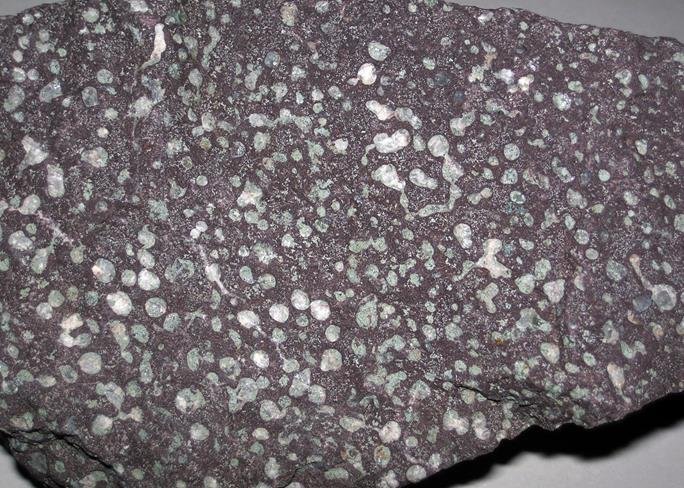Amygdaloidal basalts are basalt rocks with vesicles partially or fully filled with secondary minerals.
The filled vesicles are called amygdales, while amygdaloidal describes any rock with these filled vesicles or texture. Tiny ones are amygdules.
Minerals in amygdales are deposited after lava solidification by hot fluids and underground water. These minerals include chlorites, zeolites, agate, quartz, opal, calcite, prehnite, etc.
The word amygdala comes from the Latin word amygdala = almond. It describes the common shape that these filled vesicles have.
On the other hand, amygdaloidal basalt is the name of basaltic rocks with amygdales.

What is basalt?
Basalt is mainly dark-grey to black volcanic or extrusive rock, i.e., formed on or near the Earth’s surface.
The cooling is quick on the Earth’s surface, resulting in an aphanitic or fine-grained texture. However, it can have other textures, including vesicular, porphyritic, poikilitic, and amygdaloidal.
Its composition is basic or mafic. It has 45-52 wt.% silica, is relatively high in iron, magnesium, and calcium oxides, and is low in alkalis (sodium and potassium oxides).
Basalt is dominated by calcic plagioclase and augite. However, it may have smaller amounts of quartz, alkali feldspar, enstatite, olivine, and rarely hornblende or biotite (mica).
Some of its accessory minerals are spinel, chromite, magnetite, apatite, and ilmenite.
Description and appearance
Amygdaloidal basalts will have small, oval, nearly rounded to almond-shaped bodies, speckles, or patches. Some can be elongated or flattened.
These patches can be colorless, creamy, off-white, green, purplish, etc. Color depends on the mineral present in amygdales.
Amygdales may resemble phenocrysts. Phenocrysts are large mineral crystals set in a finer matrix or groundmass, i.e., porphyritic texture.
However, some pipe-stem amygdales may occur on the lower chilled margins of basaltic flows. They resemble stems of clay pipe. Sometimes, they are tilted, indicating that lava moved as gases exsolved.
For instance, the basaltic lava flows in the Isle of Skye, Scotland, have pipe amygdales as their base.
Usually, basalt rocks and lava flows, including flood basalts, pillow lavas, pahoehoe, and aa, can have amygdales if they have gases.
Most thick and extensive lava flows flood basalts barely have vesicles. So, they will not have amygdales. However, some will.
On the other hand, thinner and irregular flows like pahoehoe and aa lava flows will form vesicles. These vesicles are predominant in the upper zones of these flows. However, a few can occur in the lower parts.
Lastly, marine lava flows can have vesicles that will later be filled to form amygdaloidal basalt.
How does amygdaloidal basalt
During eruption or lava flows, including pillow lava flows in submarine environments, gases exsolved, forming bubbles. These gases include water vapor, carbon dioxide, and sulfur.
Some gases will escape, while others are trapped in the solidified magma, forming vesicles. When empty, these rocks will have a vesicular texture.
However, hot water-rich or hydrothermal fluids and underground water will sometimes percolate into the vesicles.
These aqueous solutions will deposit minerals inside these vesicles, forming amygdaloidal basalt.
For instance, near-surface fluids will circulate through vesicles near the surface of lava flow, depositing minerals.
Common minerals in amygdaloidal basalt
Most of the minerals in amygdaloidal basalt precipitate at low temperatures. A few, the igneous or glass, can form at higher temperatures.
Some common minerals in basaltic amygdales include quartz, calcite, prehnite, chlorite, prehnite, datolite, pectolite, saponite, pumpellyite, apophyllite, and zeolites.
Besides calcite, these rocks may have other carbonates, like dolomite and aragonite. Also, they can have silica polymorphs, such as opal, chalcedony, and agate.
Agates may have druses of amethyst crystals, such as those found in Irai, Rio Grande do Sul, Brazil. Druses are well-developed crystals that project from the inner surface of vesicles.
On the other hand, zeolites will include natrolite, chabazite, modernite, stilbite, heulandite, phillipsite, analcime, etc.
If you didn’t know, basalts are known to have the best zeolites. These zeolites form from late-stage magmatic hydrothermal fluids.
Less common minerals in basalt amygdales include pumpellyite, okenite, thomsonite, glauberite, axinite, anhydrite, etc.
Additionally, mafic lava flows can have jadeite-bearing amygdales. They probably analcime amygdales metamorphism.
Lastly, some amygdaloidal basalts can have glass or igneous minerals. Such will indicate that the filling happened at a high temperature.
Uses and significance
Amygdaloidal basalts are dense, durable rocks. Uses include construction aggregate, dimensional stones, fertilizer dust, landscaping, etc.
Also, some c may have native copper deposits. For instance, Keweenaw amygdaloidal basalts in Great Sand Bay beach on Lake Superior, Michigan, USA, have native copper of significant economic value.
Also, it occurs in small shafts and pits in the Montrose locality, Upper Eau Claire Lake, in Wisconsin.
Lastly, some amygdaloidal basalts may have the agate, a banded chalcedony variety. Agate is a popular ornamental gemstone.

Value or price amygdloidal basalt imho